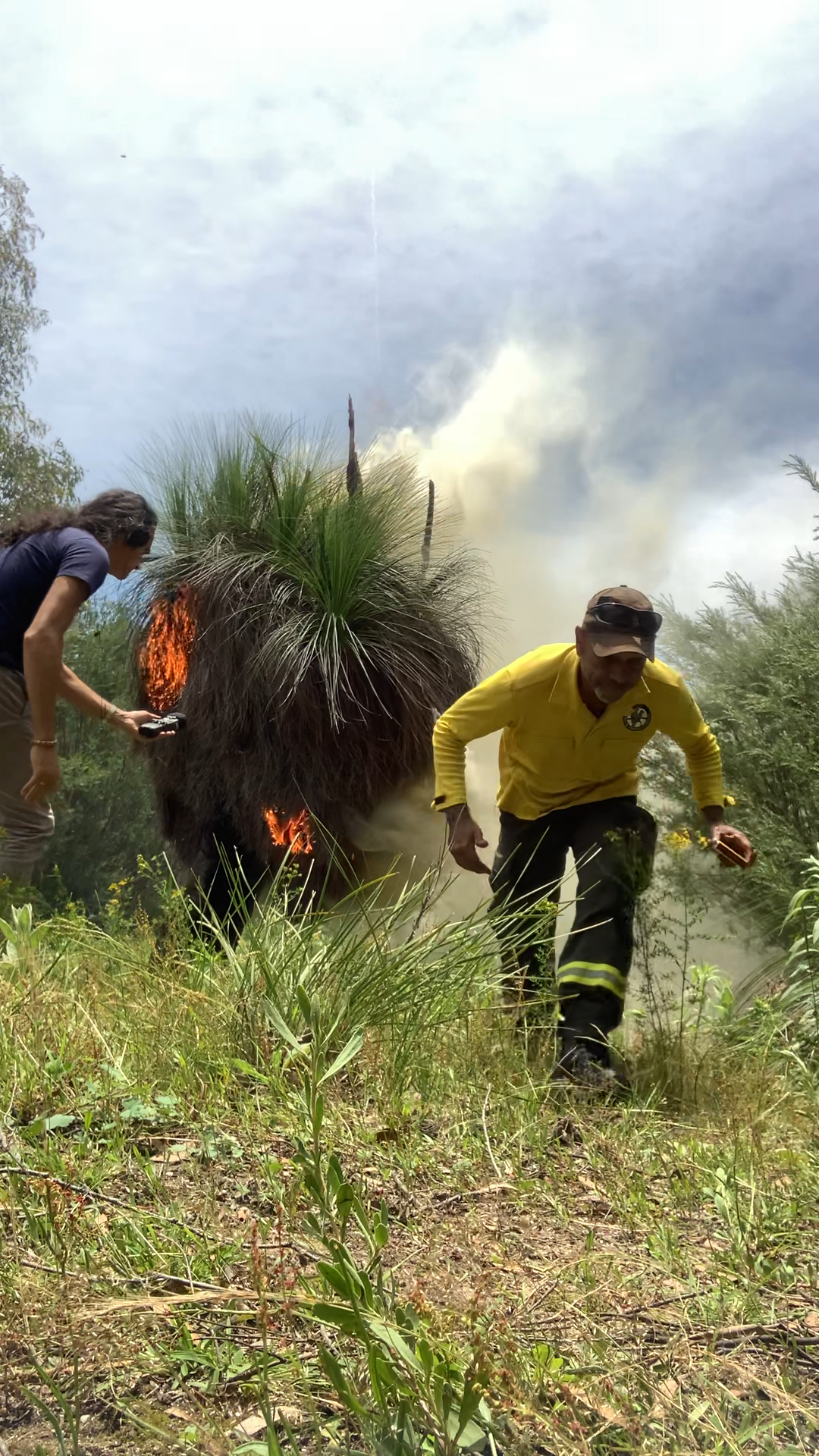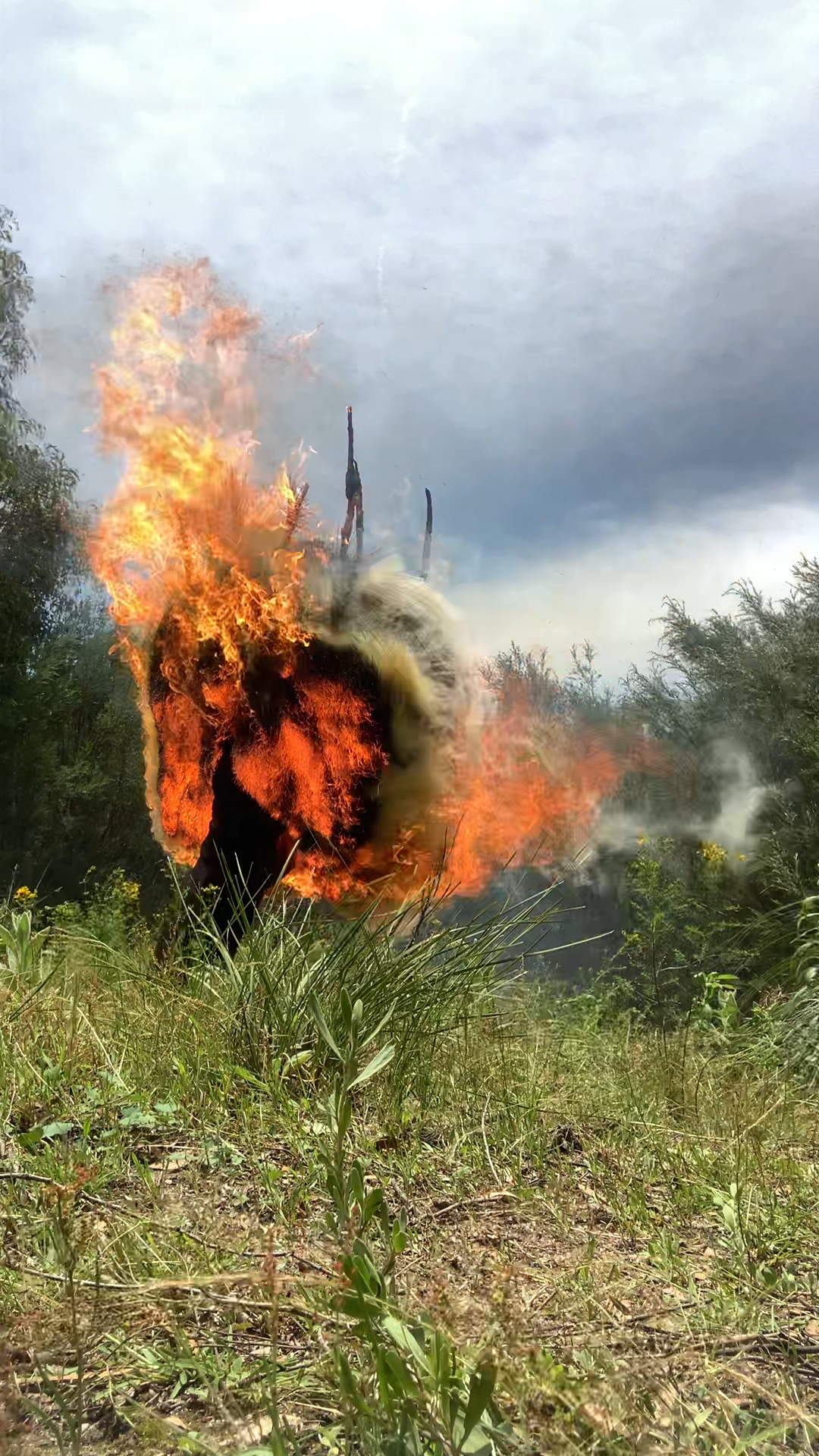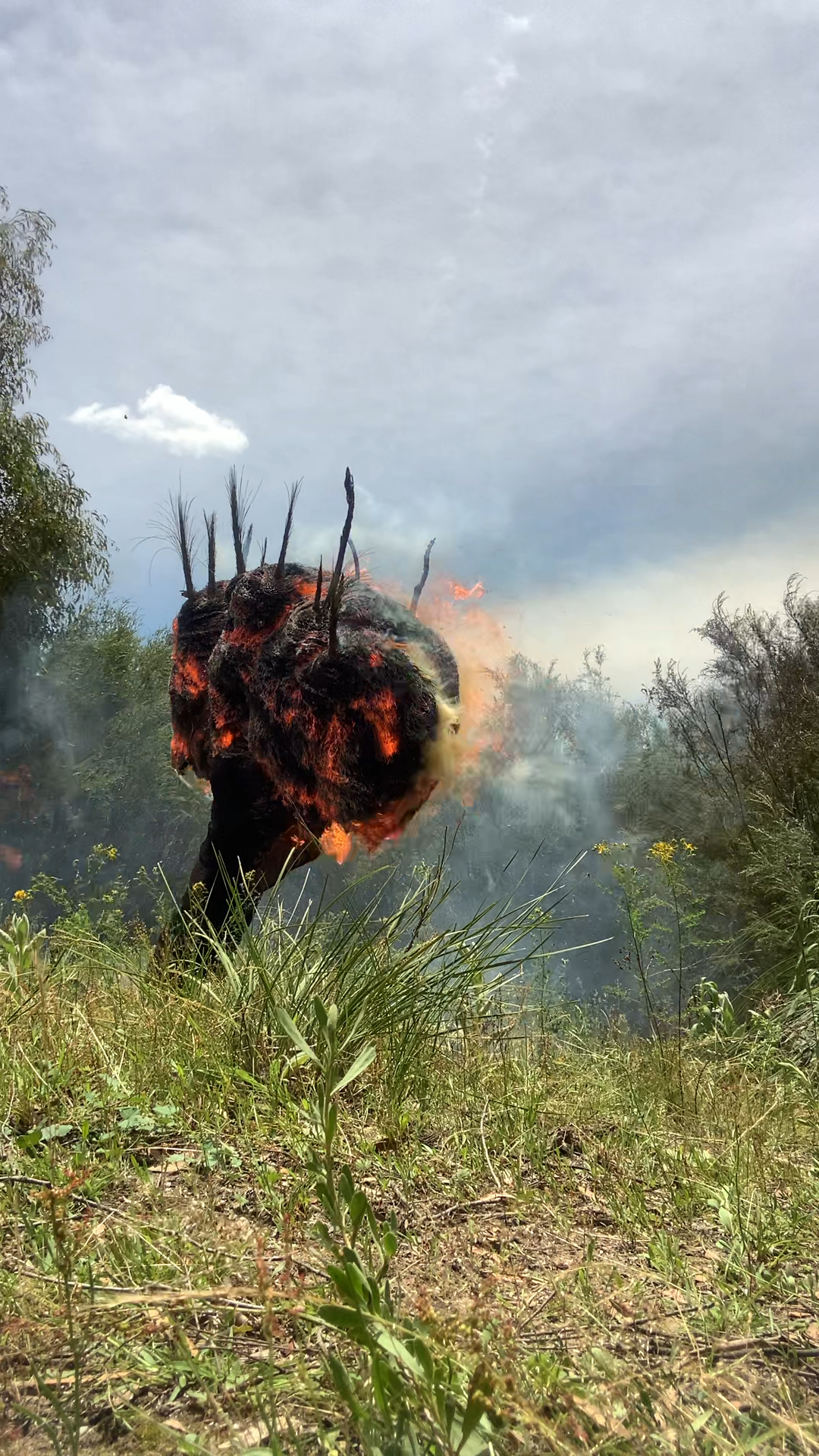With sound and music as witness, this is evidence that can disassemble and reassemble the Western cannon that hyper-seperates humanity and nature. The burn was led by Indigenous ranger Dean Freeman at Pierces Creek Forest in the Australian Capital Territory, with composer Kim Cunio recording the sounds, and creating an electroacoustic/sonic work, and scholar Jessica Weir assisting with the text. In addition to Dean, four Indigenous and non-Indigenous rangers from ACT Parks and Conservation Service assisted with the burning and were present during the recording. We acknowledge the support of Ngunnawal Elder Warren Daley who wanted to attend but had prior commitments.
This electroacoustic/sonic work And the Grass Tree Burns, Pierces Creek Forest combines sound recording, composition and performance to respond to being in Country with fire. The sounds of the grass tree burn recording are processed carefully to spatialise them for those who like headphones or good stereo systems, and an accompanying musical narrative made by Kim Cunio uses music as an aid to bearing witness. These weave through the beauty of Pierces Creek with four pieces of work that convey Kim’s lifeworlds from Iraq and India, and his work with traditional music globally and through history. We are in a clearing and we see around us a group of grass trees. Around those trees are the grass lands that help sustain a diversity of life. All is connected into these lifeworlds through the global movement of so many people to protect what we are losing, together. The four pieces of music:
First, a piano prelude to accompany the lighting of the fire. This piece written and played by Kim is a response to being in the beauty of Pierces Creek Forest. This is impressionistic music because all of us are gaining a sensory experience. This type of listening does not need intellectual rigour; it needs stillness.
Second, an alap which is a composition in the system of North Indian Hindustani music making without rhythm. Kim played this piece as a statement of optimism, and because making music with no western harmony is deeply restful to the ears. It also unites the global South and Indigenous peoples, both with music traditions that do not rely on chords or notated music as parameters of music making. The composition is for the Indian Santour and Tanpura in the very major Rag Bilawal.
Third, this music moves us into the centrepiece of the experience. It is a new setting of Hildegard of Bingen’s Sequence for the Holy Spirit, O Ignis Spiritus: a masterwork about the sacred fire and life force in all living things that sees our world as inherently miraculous. Hildegard lived from 1098-1179 in what is now known as central Europe and was a great activist in the Benedictine world she came from. Sung by early music specialist Heather Lee, this is a deep experience that invites us to slow down with fire. It also allows reflection on a 900 year old Western masterwork that is so very young compared with Indigenous song and story.
As the fire builds in intensity we hear the African Kalimba in a short solo that dances with the flames. The Kalimba is an instrument of the poor, made from flat nails and a simple tin – often a sardine tin. It’s nickname ‘thumb piano’ reflects how it was developed as a ‘serious’ instrument alongside the might of European colonialism, with a visceral beauty and intimacy. Kim played this with an ambisonic microphone placed in his ears so that we can all hear this instrument it as he heard it.
Our final piece again slows with the fire. We hear an electronic work composed in the most beautiful of modern musical intervals: the differences in pitch known as ’the third’. This piece conveys our emotions, before it is overtaken by a late entrant – a fly! The fly plays with the microphone in the last minute of the recording, emphatically stating that it is here too.
O ignis spiritus, Hildegard of Bingen Sequence for the Holy Spirit. Rupertsberg. fol. 471
O ignis Spiritus Paracliti, vita vite omnis creature, sanctus es vivificando formas.
Sanctus es ungendo periculose fractos; sanctus es tergendo fetida vulnera.O spiraculum sanctitatis
O ignis caritatis.
O dulcis gustus in pectoribuset infusio cordium, in bono odore virtutum.
O fons purissime, in quo consideratur, quod Deus alienos colligit et perditos requirit.
O lorica vite, et spes compaginis membrorum omnium et o cingulum honestatis, salva beatos.
Custodi eos qui carcerati sunt ab inimico, et solve ligatos, quos divina vis salvare vult.O iter fortissimum quod penetravit omnia; in altissimis et in terrenis, et in omnibus abyssis tu omnes componis et colligis.
De te nubes fluunt, ether volat, lapides humorem habent, aque rivulos educunt, et terra viriditatem sudat.
Tu etiam semper educis doctos per inspirationem Sapientie letificatos.
Unde laus tibi sit, qui es sonus laudis, et gaudium vite, spes et honor fortissimus dans premia lucis.
O fire of the Paraclete Spirit, the life in every creature’s life, you are holy in giving life to forms.
You are holy in anointing the dangerously stricken; you are holy in wiping fetid wounds.O vent of holiness, O fire of love. O sweet taste in our breast
and fragrance of virtues flooding our hearts.O purest of fountains, in whom is shown that God gathers together those who are far, and finds those who are lost.
O breastplate of life and great binding hope to all the members [of Ecclesia].
O sword belt of honour, save the blessed.Guard those souls whom the enemy has taken, release all those captives that the divine power wills to save.
O most constant path reaching to the heart of all things; in heaven and earth, and in every abyss you call us all together.
You make the clouds issue forth, and the high airs fly, you give the stones their presence, you bring forth the water’s streams, and make the earth sweat with green things.
Indeed, you always teach the learned, those whom the inspiration of Wisdom has made glad.
And so all praise be to you, you who are the very sound of praise, and the bliss in life, you who are hope and the greatest honour, giving the gifts of light.— Translation Kim Cunio Broadcasted by the ABC (Australian Broadcasting Commission) in 2007
Grass Tree Living Burn Sound Recording
People have been recording sound for quite a long time. Sound is also known as ‘musique concrete’ which music students study as part of their foundational work all over the world. Yet, as recording sound becomes more accessible for more people, we are rapidly losing our ability to observe so much of our sonic world. We are losing our capacity to listen to the earth with an open heart as we are flooded with so many human sounds. In response, we offer the raw sounds of burning this grass tree to be listened to intently.
Dean lit the fire with the utmost care for all of us, while Kim came with a digital recorder, a windsock and an extra pair of socks to mitigate the windy day of the burn. The sound quality of the microphone is not static in this recording as the recorder was not set on a stand or on the ground. Kim held it to him and moved with the fire and danced with the wind, shielding the microphone with his body, listening for all of us to the sounds, moving in and out to capture the sonic details of individual flames as they jumped, twigs cracking, insects scurrying, wind changing direction, new bursts of flame.
When you listen imagine yourself sitting with the rangers who undertook this experience in complete silence, taking rest in the recuperative power of Country – the homelands of the First Nations. Listen to the power of the fire as it burns inside one tree, bringing life to itself in the process. Imagine the force of this living monument that provides refuge for thousands of insects and provides an all-important resin for Indigenous life on Country and more.
This piece offers a chance for all of you to ’meet’ Dean and the other rangers present. We can shut our eyes and sit with them as they sat with the grass tree burn. We can walk with them and feel their friendship and love.
Living Burn Triptych
Grass trees grow slowly and this one is close to 200 years old, much older than the Australian capital established here in the early twentieth century.
Dean is lighting the grass tree as part of his government job with the Parks and Conservation Service, with other rangers nearby to assist and a water tank and pump on stand-by. Later, the Indigenous rangers talk about how emotional and meaningful it is to be involved in something practiced by their ancestors with Country. The non-Indigenous rangers say it is unreal and fascinating to be present.
So many grass trees have not been burnt by Indigenous people because of the cumulative impacts of the British Empire, which has sought to wrestle land ownership and authority from the First Nations. “We are getting back into them,” says Dean, “We are getting back into them.”
As the fire crackles everyone is present. The workplace language of ‘hazard’ for fire’ and ‘fuel’ for the bush shifts restlessly in the glaring sunlight.
The Parks rangers are also responsible for fighting terrifying bushfires on these slopes when black smoke turns day into night. Wildfires, we call them bushfires, are increasing in frequency and intensity in Australia, as the whole world now knows. In the summer of 2019-2020 smoke formed out of our trees and grasses circled the earth. These are lives lived in relation, as climate change is also making it emphatically known.
During and after that horrific summer, calls were made for Indigenous peoples’ leadership to help protect Australia from a future repeat. What did this mean? The transfer of specific fire skills to fire agencies to reduce the hazard? Or? Is it possible to live together in respectful relation with Country?
Such ethics and practise is the kind of thinking that Seedbox is valuably nurturing in The Community Garden. Indigenous leaders need to be taken very seriously to unpick the abstraction of humanity from nature, and foreground the consequential relationships held with all life on earth.
Photos: Dean Freeman











